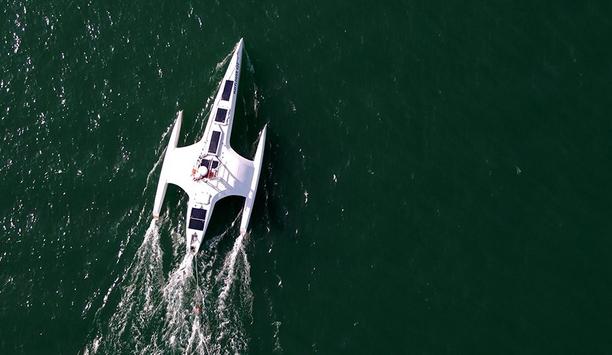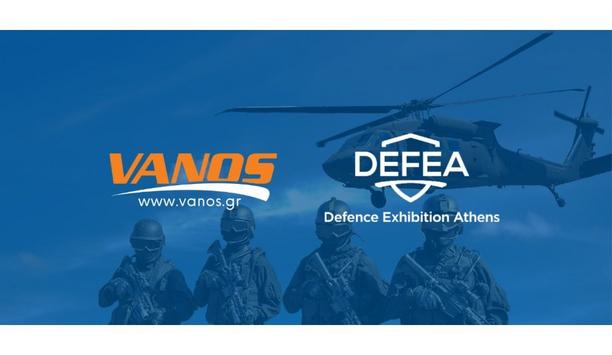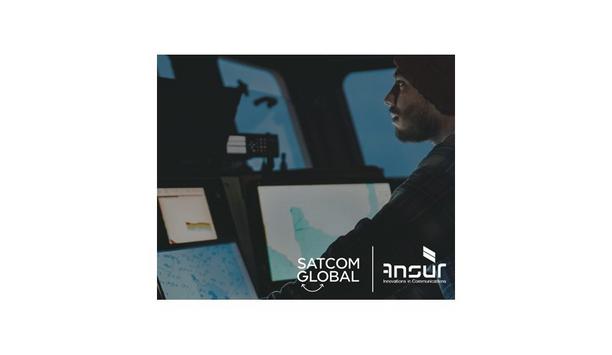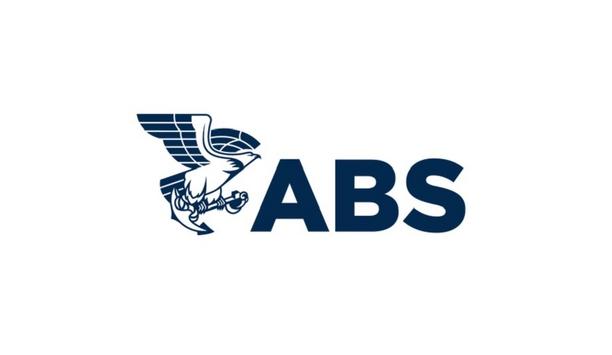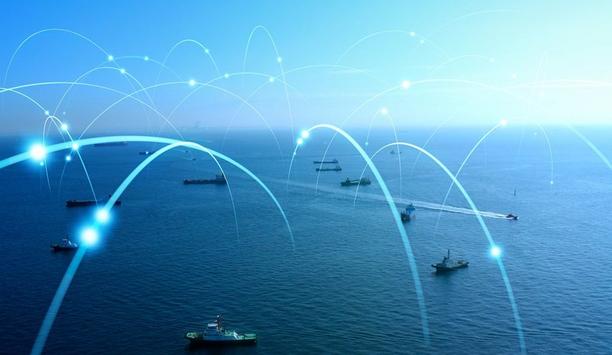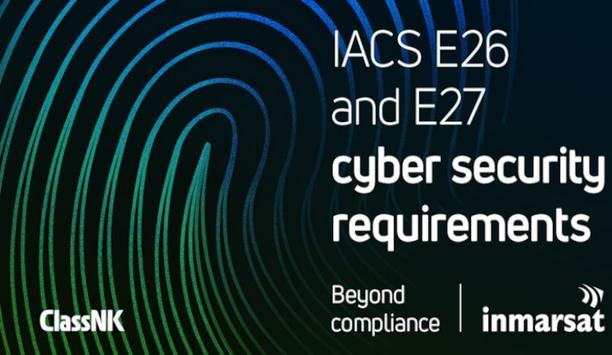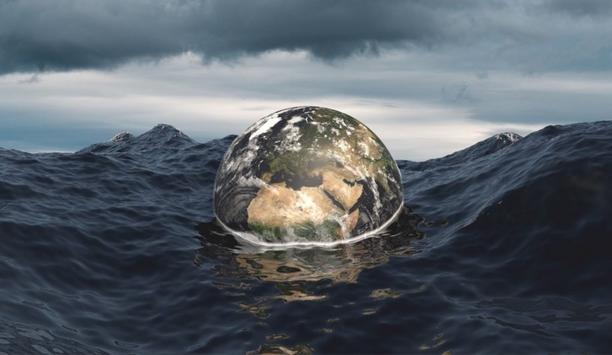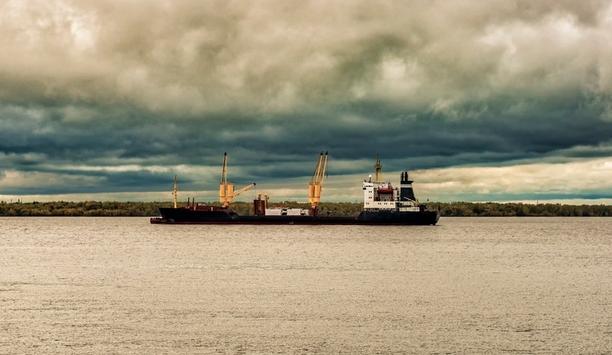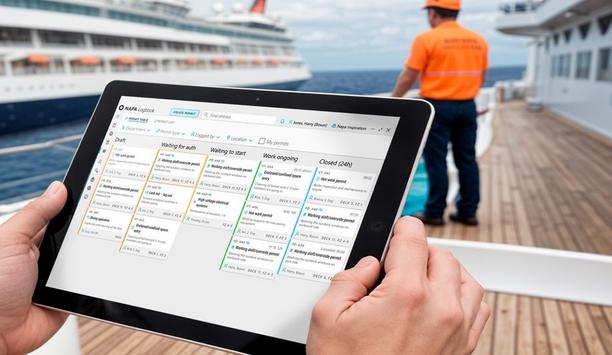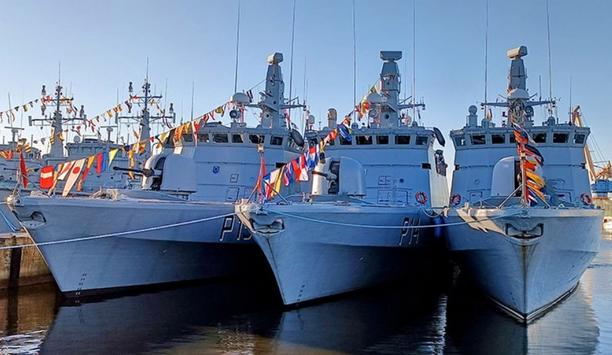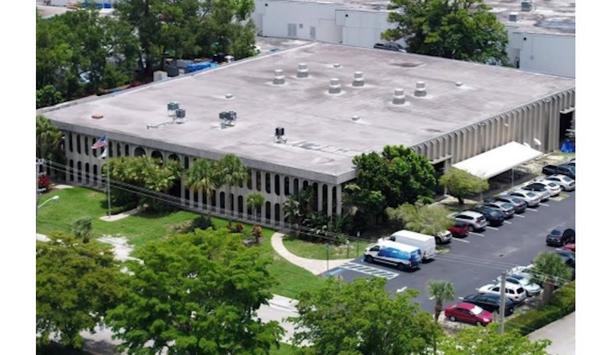Security









News
In a landmark event, a meticulously reconstructed 5th-century wooden stitched ship was launched into the waters of the Mandovi River in Goa. This endeavour, a collaborative effort between the Ministry of Culture, the Indian Navy, and Hodi Innovations Pvt. Ltd., signifies a monumental step in reviving India's ancient maritime traditions. Modern stability and strength needs IRS has been instrumental in this project, ensuring that while the vessel retains its historical design Indian Register of Shipping (IRS) has been instrumental in this project, ensuring that while the vessel retains its historical design, it also meets contemporary safety and design standards. Drawing inspiration from a mural in Maharashtra's Ajanta Caves, the ship has been constructed using age-old techniques, with planks stitched together using coconut coir rope—a method perfected by Indian shipwrights centuries ago. IRS's expertise has been crucial in refining the vessel's design to comply with modern stability and strength requirements, ensuring its seaworthiness for the upcoming voyages. Modern safety standards Cdr K Dhawan, Head Defence, stated: "Reconstructing this ship is a tribute to India’s maritime heritage and demonstrates the commitment of IRS to the Indian Navy’s efforts to keep alive India’s ancient maritime tradition." "Our involvement in this project reinforces our commitment to preserving traditional shipbuilding techniques while ensuring the vessel meets modern safety standards. It is a proud moment for us to be part of an initiative that bridges history with present-day innovation." India's rich maritime legacy The ship is set to embark on memorial voyages later this year, retracing old trade routes The ship, entirely designed and built in Goa, is set to embark on commemorative voyages later this year, retracing ancient trade routes to destinations such as Muscat and Indonesia. This initiative not only celebrates India's rich maritime legacy but also exemplifies the nation's commitment to preserving its heritage while embracing contemporary innovation. Future endeavours in maritime heritage The Stitched Ship Project stands as a testament to India's dedication to honouring its seafaring ancestors and preserving traditional shipbuilding techniques. The collaboration among multiple ministries, the Indian Navy, Hodi Innovations, and IRS exemplifies a harmonious blend of tradition and modernity, setting a precedent for future endeavours in maritime heritage conservation.
In recognition of its exceptional achievement in maintaining a safe work environment, the National Safety Council (NSC) presented ABS with two safety awards. The NSC is a globally recognised nonprofit organisation committed to eliminating leading causes of preventable death and injury in the workplace and on roadways. Their awards program recognises organisations and individuals who have made significant contributions to upholding the safety of their workplaces and communities. ABS’ accomplishment ABS has accumulated more than 15 million hours worked without a lost-time incident The two awards celebrate ABS’ accomplishment of reaching a significant number of consecutive hours without incurring occupational injury or illness that resulted in days away from work. Since January 2023, ABS has accumulated more than 15 million hours worked without a lost-time incident (LTI). The second award recognises six million hours worked without an LTI specific to North American operations dating back to 2021. ABS new benchmarks “This achievement is a testament to the dedication and hard work of ABS employees in maintaining a safe work environment across all of ABS globally,” said John McDonald, ABS President and COO. “We are incredibly proud to receive these awards and will continue to prioritise a strong culture of safety so that ABS can strive to set new benchmarks within the industry.” ABS safety meetings ABS staff have regular safety meetings to discuss specific safety issues relevant to individual teams Safety is at the heart of everything ABS does, whether in its own operations or in promoting safety for the maritime industry at large. ABS staff have regular safety meetings to discuss specific safety issues relevant to individual teams and offices. Marine and offshore industries Staff are also empowered with the knowledge, tools and authority to maintain safety at work and in everyday life. This safety-centric mission extends to ABS’ industry-pioneering classification and technical advisory services, providing a crucial foundation in helping the global marine and offshore industries achieve a safer, cleaner future.
Transport Secretary, Heidi Alexander, said: “Today we mark significant progress in our journey to creating a greener, cleaner planet with a landmark agreement at the International Maritime Organization." “We have worked closely with international partners to forge a path for sustainable shipping internationally and secure a prosperous, resilient sector, laying a strong foundation for the future." Development of clean fuels Alexander added: “This deal means that ships will be incentivised to reduce greenhouse gas emissions, driving forward the development of clean fuels. Measures agreed this week will help the whole sector decarbonise and support developing countries, ensuring a just transition for all." “Combined, our international and domestic work will help establish the UK as a clean energy superpower and will kickstart economic growth through investment in clean fuels and technologies.” Background The agreement reached now mandates international shipping only. Changes will be brought into force from 2027.
How to take the industry’s ‘ultimate planning tool’ and improve it? Giving users what they need, often before they know they need it, and staying ahead of evolving trends and regulations? Timo Essers, e-Navigation Director at NAVTOR, explains the philosophy driving the continual evolution of NavStation, while outlining the headline updates to the soon-to-be released NavStation 6.4. Navigators and shipping businesses "When you have products and services onboard over 18,000 vessels you tend to get a lot of feedback!" said Timo Essers may be grinning broadly, but he has a very serious point. The Dutch-born e-Navigation Chief at Norwegian-headquartered NAVTOR says he, and his global team, are committed to 'making life easier' for both navigators and shipping businesses, but to do that they have to understand current and future pain points. Maritime planning capabilities Partnership now pushing maritime planning abilities to new heights with the release of NavStation 6.4 "It’s not up to us to dictate to users, but rather to have them dictate to us – sharing their experience so we can use ours, both digital and navigational, to come up with optimal solutions," says Timo Essers, adding: "This industry is increasingly complex, with new regulations, guidelines, commercial considerations, reporting requirements, and risks emerging continually." He continues, "By putting the customer at the absolute centre of everything we do, and understanding their challenges, we can help them navigate this complexity simply, efficiently and profitably. In that way we’re not really a supplier – more of a partner. Always onboard to deliver added value, translating demands into innovations." It's a partnership currently pushing maritime planning capabilities to new heights with the upcoming release of NavStation 6.4. Transforming efficiency Launched in 2014 as the maritime industry’s first digital chart table, NavStation has spent the last decade cementing a position, in Essers’ words, as 'the ultimate planning tool'. Update after update has seen the software adding an increasing number of business- and operation-critical data layers and modules seamlessly over ENCs, putting 'everything a navigator needs at their fingertips'. The platform offers everything from weather routeing, to detailed port information, environmental regulations, AMVER reporting, a manoeuvring assistant, NAVAREA warnings, and much more, while automating tasks and auto-populating reports to slash administration, eradicate errors and enhance vessel and fleet efficiency. NavStation’s Passage Planning module NavStation’s popular Passage Planning module is a case in point, reducing time on each task NavStation’s popular Passage Planning module is a case in point, reducing time on each task from an average of 3.5 hours to 30 minutes, or less. “We may work in maritime technology, but the majority of the team here have extensive vessel experience,” says Essers, who is himself a seasoned navigation officer. “So, this is a platform made for navigators by navigators. We know the pressure our users are under. Thankfully, as we’ve shown with Passage Planning, we also know how to make things easier for them.” It's a process that, like the industry it serves, never stops. Small steps, big advantage Essers reveals that NavStation 6.4 sees a broad spectrum of enhancements, 'taking functionality and futureproofing to a new level.' In terms of functionality it has a vast range of 'small but powerful' improvements, he notes, including better search capabilities, advances in auto-routing (such as automatically blocking waterways for certain vessels based on the latest AIS tracking intelligence), integrating port and trade statistics into the extended ports database, the ability to combine company regulations with environmental regulations, and much more. NAVTOR’s ability to stay ahead of the curve and help customers navigate the future is shown in 6.4’s new S-100 compatibility. Enhancement of NavStation 6.4 The integration of real-time Security Risk Data from Risk Intelligence as a new, flexible subscription offering "Much of the industry may not be aware of the scale of change ahead with the upcoming S-100 data standard," states Timo Essers, adding "Transforming static charts into more dynamic, 3D, data-rich formats." He continues, "By making NavStation compatible, and giving users the ability to access data such as S-102 (bathymetric surface data) now, we can help them get to grips with this new navigational reality - understanding the benefits, honing skills, and easing future adoption. It’s a tangible example of how our approach delivers real added value." As is, arguably, the headline enhancement of NavStation 6.4, the integration of real-time Security Risk Data from Risk Intelligence as a new, flexible subscription offering. By the side worldwide “We’ve been working towards adding an up-to-the-minute risk layer over ENCs for some time,” Essers says, adding that it’s been, in his view, “a missing piece of the e-Navigation puzzle.” Now, however, that piece is firmly in place, allowing navigators, and relevant shore-side teams, to plan and understand voyages with safety and simplicity, fully aware of maritime’s ever-changing risk picture. Navigational jamming and spoofing Timo Essers explains: "From conflict and ongoing geopolitical unrest, to piracy, narcotics, and people smuggling - in addition to increasing navigational jamming and spoofing - today’s shipping companies face a complex and ever-evolving threat landscape. Navigators are, in many ways, on the front line, and as such are under immense pressure." He continues, "However, with clear, customisable and relevant notifications layered onto ENCs – empowered by Risk Intelligence’s world-pioneering team of expert analysts – our users can now approach planning with informed peace of mind. We see this as a landmark development for our own product, but also for the industry – enabling safer, simpler and smarter navigation in a changing world of threat." Privilege and passion Despite the major updates, level of innovation and ability to lead the way in e-Navigation, Timo Essers insists "We’re not there yet, there’s more to come. I’m incredibly proud of what we, in conjunction with our partners and customers worldwide, have achieved with NavStation. We are delivering on our promise of developing smart solutions that make life easier for shipping companies, benefiting the whole industry." He smiles, adding, "I’ve always said we want to voyage towards perfection. But, in an ever-changing industry, that means perfection is shifting all the time – it’s a moving target. Although this could be somewhat of a depressing realisation – you put your heart and soul into a project only to find it’s never actually completed – Essers’ sees through an entirely different lens." Navigator planning “I enjoy the voyage,” says Timo Essers, with a beam worthy of any navigator planning the optimal route ahead. He continues, "Shipping is dynamic, that’s what makes it so interesting, and innovating to match evolving customer demands is both a privilege and, I think I can speak for the whole team, a passion. So, I’m looking forward to plenty more feedback, and developments, in the years to come."
Expert commentary
When the Ballast Water Management (BWM) Convention came into force in 2004, it was in response to a crisis we couldn’t afford to ignore—one where invasive aquatic species, carried silently in ships’ ballast tanks, were devastating marine ecosystems. Now, two decades later, compliance with this environmental safeguard is no longer optional—and yet, as recent industry findings reveal, record-keeping failures account for 58% of compliance issues. That’s not a technology problem. That’s a documentation problem —one rooted deeply in data management practices and crew training, where small oversights lead to documentation issues, that may cascade into costly compliance failures. And that’s precisely where digital systems excel, guiding crews clearly to avoid mistakes in the first place. New ballast regulations At the IMO’s 82nd Marine Environment Protection Committee (MEPC 82), new ballast water record-keeping regulations were approved, coming into effect from 1 February 2025. These updates mark a significant tightening of documentation standards—and they could catch unprepared shipowners off guard if not acted on promptly. Why ballast water record-keeping is back in the spotlight These new updates aim to change that—and they’re stricter, smarter, and more detailed than before While MEPC 82 made headlines for advancing decarbonisation policies and ECAs in the Arctic and Norwegian Sea, it also honed in on ballast water—a topic that has quietly regained importance. The committee approved critical updates to how ballast water operations and ballast water management system (BWMS) maintenance are recorded. The goal: Enhance transparency, reduce ambiguity, and reinforce environmental protection by making records more structured, traceable, and actionable. This renewed focus is both a warning and an opportunity. In recent years, too many Port State Control detentions and inspection delays have stemmed not from hardware failures, but from poorly maintained or unclear ballast water records. These new updates aim to change that—and they’re stricter, smarter, and more detailed than before. What’s changing: Bypass scenarios and maintenance logging The revised guidelines introduce two new scenarios for vessels dealing with challenging water quality (CWQ) in ports: Scenario 3: A reactive bypass of the BWMS due to unforeseen poor water quality. Scenario 4: A pre-emptive bypass based on anticipated CWQ conditions. These additions are essential for vessels operating globally, particularly those above 400GT. They ensure that alternative operations—like ballast water exchange plus treatment (BWE + BWT)—are clearly documented. Without accurate records, even legitimate actions can fall short of compliance. Ballast Water Management Plan and OEM manuals MEPC 82 also mandates that BWMS care procedures must now be recorded directly in BWRB MEPC 82 also mandates that BWMS maintenance procedures must now be recorded directly in the Ballast Water Record Book (BWRB), in line with the ship’s Ballast Water Management Plan and Original Equipment Manufacturer (OEM) manuals. Responsible crew members must sign off on these records, ensuring traceability and crew accountability. This step isn’t just regulatory housekeeping—it aligns ballast water maintenance with how other onboard systems are already tracked, from engines to emissions. It’s a logical, overdue move toward consistency across compliance. Paper or digital: The format dilemma While the BWRB can still be maintained on paper or electronically, the burden of new structured data fields and stricter reporting timelines will be felt most by those still tied to manual systems. Each additional layer of documentation increases the chance of human error—and with nearly 6 in 10 compliance failures already stemming from admin issues, that’s a risk many operators can’t afford. This is where digital solutions can offer real relief. At NAPA, we’ve already implemented the latest IMO guidelines into our electronic logbook, so crews can comply with MEPC.369(80) requirements out of the box. With ready-made entry templates and smart input validation, data entry is quick, accurate, and audit-ready. NAPA implemented the latest IMO guidelines into an electronic logbook. Better still, once updated, operators can apply for the BWM Convention Electronic Record Book Declaration from their flag—ensuring that compliance is recognised internationally under MEPC.372(80). Less admin, more assurance Electronic logbooks don’t just streamline compliance—they enable better decision-making. When connected to onboard systems, they automatically pull operational data into the BWRB, reducing manual work and error margins. This frees up the crew to focus on operations and safety, rather than paperwork. From a management perspective, real-time visibility into ballast operations and maintenance records helps shore teams stay ahead of inspections and identify potential compliance gaps early. One logbook, many regulations While ballast water is the focus today, it’s not the only regulation demanding attention While ballast water is the focus today, it’s not the only regulation demanding attention. At NAPA, we’ve designed our logbook to support a wide range of evolving compliance frameworks—including MARPOL, EU-ETS, EU-MRV, CII, and the Garbage Record Book. This unified approach removes silos, reduces duplicated effort, and gives operators a more holistic view of vessel performance and compliance. A smarter way forward With decarbonisation and environmental regulations shifting at breakneck pace, even the most experienced crews and fleet managers can struggle to stay up to date. That’s where technology has a crucial role to play—not to replace expertise, but to support it. At NAPA, we work closely with shipowners and operators to configure regulatory record book templates according to their fleet workflows and each vessel’s specific operational profile. This ensures accuracy, ease of use, and most importantly, continuous compliance—even as the rules keep changing. Because in today’s compliance landscape, staying ahead isn’t just about meeting the minimum. It’s about building systems that help you adapt, respond, and thrive. And that starts with getting the record-keeping and data management right.
Maritime communications came a long way before they could deliver the first Global Maritime Distress and Safety System (GMDSS). Still, it is fair to say that their forward march has only accelerated in the two-and-a-half decades since. Today, shipping companies rely on satellite connectivity to protect their vessels and people and enable the digitalisation, decarbonisation, and crew-welfare initiatives on which its successes rely. Low-Earth orbit (LEO) networks Against this background, the new generation of low-Earth orbit (LEO) networks has entered the maritime market to great fanfare and expectation from ship owners, and their excitement is justified: LEO satellite coverage has the potential to span the globe, providing exceptional reliability and speed even during long voyages in the most remote locations. This facilitates real-time communication and efficient coordination between vessels and onshore personnel, ultimately supporting more profitable and sustainable fleet operations. Level of connectivity Moral obligations and regulatory requirements aside, providing high-quality crew internet LEO’s introduction into the maritime sphere has been equally well received by seafarers, who stand to benefit from a level of connectivity that keeps them better connected to family and friends than ever before, and to richer entertainment options at sea. Moral obligations and regulatory requirements aside, providing high-quality crew internet represents a wise investment from a competitive standpoint, enhancing as it does an organisation’s ability to attract and retain the brightest talent. Another advantage to seafarers and their employers, LEO connectivity offers stable onboard access to non-leisure services including mental-health support, telemedicine, and online learning resources, helping to keep a crew happy, healthy, and up to speed with the evolving requirements of their job. Limitations For all the benefits of LEO networks, it is important to acknowledge their limitations. For instance, LEO’s promise of delivering worldwide coverage remains to be realised, with certain countries yet to authorise its use in their territorial waters. This means that, depending on the trading route, a ship may encounter multiple LEO-coverage blackspots during its voyage. Susceptible to interference Regardless of the network type being used, vessels still need to compress and throttle data Like many satellite technologies, LEO networks are also susceptible to interference from atmospheric conditions that can disrupt communications, while network congestion at hotspots and drop-out at satellite handover may present additional connectivity challenges. Regardless of the network type being used, vessels still need to compress and throttle data on certain occasions, such as while in port, but LEO networks currently cap utilisation and therefore limit connectivity and availability further. Crew and commercial use In addition, maritime organisations should consider whether their LEO system is for both crew and commercial use. For a vessel deploying LEO connectivity to cover crew and business communications simultaneously, even a terabyte of data is unlikely to go far. Divided among a crew of 25, it equates to 40 gigabytes per person, enough for 13 hours of HD streaming with nothing remaining for commercial requirements. The solution Maritime software including critical communications-based services will need to be compatible with LEO To ensure reliable and consistent connectivity, support enhanced GMDSS communications, and meet the bandwidth needs of all stakeholders, a vessel will require multiple satellite provisions. This means that maritime software including critical communications-based services will need to be compatible with both LEO and more traditional, low-bandwidth networks and be able to switch between connections automatically to ensure uninterrupted service. GTMailPlus GTMaritime’s GTMailPlus, for example, is compatible with all major network types, regardless of bandwidth. Developed with optimisation in the maritime environment in mind, it provides secure and efficient data transfers irrespective of the service or combination of services a shipowner or manager uses. If disruptions do occur, GTMailPlus resumes data transmission from the point of interruption. Risk of a cybersecurity breach There have already been several reported cases of ship owners falling victim to significant cyber incidents As crew freedoms on the Internet increase and more onboard devices are connected to the network, the risk of breaches to cybersecurity is also rising dramatically: effectively, the vessel becomes a larger attack surface. There have already been several reported cases of ship owners falling victim to significant cyber incidents having adopted LEO systems without taking the necessary security precautions. Robust, intelligent, and scalable network Given that ships transfer diverse types of data that often involve critical and sensitive information, the consequences of any breach of vessel operations, safety, and privacy can be severe. Here too, the GTMaritime portfolio is continuously evolving to ensure robust, intelligent, and scalable network protection for owners. AI-based next-gen anti-virus technology In addition to the enhanced security features included in all GTMaritime solutions, enables a holistic approach In the latest partnership with CrowdStrike, GTMaritime’s cyber-security offering combines AI-based next-generation anti-virus technology with end-point detection and response capabilities. This, in addition to the enhanced security features included in all GTMaritime solutions, enables a holistic approach to vessel security. Conclusion LEO networks undoubtedly present a considerable opportunity for the maritime industry and have the power to transform connectivity at sea. However, there are several factors to consider before adopting an LEO system and regardless of advances in technology, optimised solutions for critical communications, security, and data transfer remain essential.
Aiming to establish minimum requirements for the cyber-resilience of newbuild vessels and their connected systems, IACS unified requirements (URs) E26 and E27 provide a new benchmark for shipping’s response to its growing exposure to cyber-attacks. Officially in force from 1 July 2024 and broadly welcomed by industry, the new URs represent another step forward in strengthening Maritime's resilience to the evolving cyber threat. However, according to a thought-provoking discussion recently hosted by Edwin Lampert, Executive Editor of Riviera in partnership with Inmarsat Maritime (a Viasat company), shipping companies must still conduct comprehensive risk assessments and implement appropriate mitigation measures. Vessel’s cyber security They ensure all stakeholders are responsible for the vessel’s cyber security Kostas Grivas, Information Security Officer, Angelicoussis Group told the ‘IACS URs E26 & E27: Bridging the gap between regulation and implementation’ session that the URs bring “obvious benefits” such as eliminating “scattered requirements”. They provide “common and crystal-clear ground for auditing and control purposes”, and establish “a solid description of the minimum technical, procedural, and other criteria that govern a vessel’s cyber resilience,” he said. Finally, they ensure “all stakeholders are responsible for the vessel’s cyber security”. Makiko Tani, Deputy Manager, Cyber Security at classification society ClassNK, also acknowledged that the new requirements will “contribute to the visibility of ever-digitalising shipboard networks and their assets”, however, as there is no one-size-fits all cybersecurity solution to all, she continued, “additional controls beyond those specified in the requirements may be necessary, depending on the vessel’s connectivity”. Digital transformation strategy To properly address the cyber risks that a specific vessel is exposed to, she said, “shipowners must conduct a thorough cyber-risk assessment. This relies on a ‘C-level commitment’ to establishing a cyber-security programme that facilitates compliance with URs E26 and E27 and any other future industry requirements while supporting the organisation’s digital transformation strategy”. The importance of looking beyond the IACS URs was also emphasised by Laurie Eve, Chief of Staff, Inmarsat Maritime, who proposed three key areas where companies should “focus and invest not only to meet new requirements but also to go beyond compliance and build good cyber resilience”. Quality management system and standards The firm should focus on training and grasping, managing user rights, investing in a regime system “The first key area, ‘people and culture’, addresses the notion that people are the weakest link in cyber security. According to a 2023 report from the United States Coast Guard as well as findings from Inmarsat’s security operations centres, phishing is the most common initial access vector in cyber-attacks. Investing in people, therefore, should be an absolute no brainer”, commented Eve. Specifically, he continued, a company should focus on training and awareness, managing user privileges, investing in a quality management system and standards such as ISO 27001, assessing suppliers’ risk-management practices, and embedding cyber-security in the organisation’s continuous improvement culture. Risk-management approach The third and final key area according to Eve is an ‘incident response plan’ (IRP). The second key area is ‘network-connected systems and services’. Given the number of attack surfaces on board a vessel and the ever-growing volumes of data moving between systems, many companies lack the time and resources to address all possible weaknesses. The solution, Eve said, is a risk-management approach in which the organisation assesses the risks, sets its risk appetite, and implements security measures according to the costs it is willing and able to bear. The third and final key area according to Eve is an ‘incident response plan’ (IRP). It’s prudent to assume that at some point there will be failures and a breach, an IRP comprises a robust set of contingencies to keep the cost of business disruption to a minimum. It requires investment in backup and data systems as well as regular staff training. “Having a plan is good; training, rehearsing, and improving the plan is better,” explained Eve. Cyber-security requirements While these recommendations apply to all ship owners, Eve acknowledged that there are differences from small to large operators in terms of the budget and internal capability invested in cyber resilience. “Inmarsat’s Fleet Secure offers a ‘one-stop shop’ for cyber-security requirements which makes it a particularly good fit for “smaller operators without the in-house capability to put together their own solutions”, he said. Inmarsat’s Fleet Secure offers a ‘one-stop shop’ for cyber-security requirements Combining three powerful components – Fleet Secure Endpoint, Fleet Secure Unified Threat Management, and Fleet Secure Cyber Awareness Training – the Fleet Secure portfolio provides the tools and facilitates a risk-management approach, supporting “compliance with the new requirements” and, more broadly, “increasing cyber resilience”, Eve added.
Harbour insights
Ammonia is gaining traction as a future fuel in the maritime industry, primarily due to its potential to significantly reduce greenhouse gas emissions. A key driver for ammonia's interest is that it can be carbon-free when combusted, which aligns with the maritime industry's increasing pressure to meet emissions regulations. However, most ammonia production currently relies on fossil fuels. Transitioning to "green ammonia" production is crucial for sustainability. If "green ammonia" is produced using renewable energy sources, it offers a pathway to near-zero emissions shipping. Safety measures and regulations Ammonia’s volumetric energy density – higher than hydrogen – makes it more practical for onboard storage. However, ammonia is toxic, which requires stringent safety measures and regulations for handling and storage. The combustion of ammonia can produce nitrous oxide (N2O), a potent greenhouse gas. Therefore, mitigation technologies are needed. Building the necessary infrastructure for ammonia bunkering and supply will be a significant undertaking. Developing guidelines for safe use Ammonia is poised to play a significant role in the maritime industry's transition to a future The International Maritime Organization (IMO) is developing guidelines for the safe use of ammonia as a marine fuel. Increasing numbers of companies are investing in the development of ammonia-fueled vessels and technologies. European Union (EU) legislation, such as the EU Emissions Trading System (ETS) and the FuelEU initiative to support decarbonisation, are pushing the maritime industry towards the use of alternative fuels, which is increasing the potential of ammonia. While challenges remain, ammonia is poised to play a significant role in the maritime industry's transition to a more sustainable future. Ongoing research and development Ongoing research and development are focused on improving safety, reducing emissions, and scaling up production. In essence, ammonia offers a promising pathway for the maritime industry to reduce its carbon footprint, but its widespread adoption depends on overcoming technical and logistical challenges. Working toward the future of ammonia Progress is already happening as the maritime industry works toward a future that includes the use of ammonia as a fuel. For example, one project underway aims to be a pioneer in establishing a comprehensive and competitive supply chain to provide clean ammonia ship-to-ship bunkering in the U.S. West Coast. Progress is already occurring as the maritime industry works toward a future A feasibility study is being conducted at the Port of Oakland, Benicia, and nearby major ports on the U.S. West Coast. A Memorandum of Understanding (MOU) between American Bureau of Shipping, CALAMCO, Fleet Management Limited, Sumitomo Corp. and TOTE Services LLC is jointly conducting the feasibility study. "We are proud to share our industry-pioneering expertise in ammonia as a marine fuel to support this study on the U.S. West Coast,” said Panos Koutsourakis, Vice President of Global Sustainability at the American Bureau of Shipping. “Our expertise in developing safety guidelines will support the consortium to address the ammonia-specific set of safety and technology challenges.” More global ammonia developments In another development, three LPG/ammonia carrier ships have been ordered at the South Korean shipyard HD Hyundai Heavy Industries (HD HHI). Danish investment fund European Maritime Finance (EMF) and international shipping company Atlas Maritime have confirmed the order. HD HHI’s parent company, HD Korea Shipbuilding & Offshore Engineering (HD KSOE), revealed the order for $372 million in March 2024. The three 88,000 cubic-metre LPG dual-fuel carriers, capable of carrying and running on ammonia, are scheduled for delivery in December 2027. The vessels will be named EMF Viking I, II, and III. Also, Lloyd’s Register (LR) and Guangzhou Shipyard International have signed a joint development project to design the world’s largest very large ammonia carrier (VLAC). The design of the 100,000-cubic-metre vessel has been assessed in line with LR’s Structural Design Assessment and prescriptive analysis. The gas carrier will have an independent IMO Type B tank for safe carriage of the chemical. Zero-emissions operations The cargo ship, which will be 7,800 dwt, is designed to transport timber from Norway to Europe “As major economies look to co-fire ammonia in their coal power stations to reduce the CO2 footprint of their national energy mix, shipping will play a key role in distributing clean hydrogen-based commodities such as ammonia, thereby supporting nations to meet their Paris Agreement commitments," says LR's Chief Executive Nick Brown. Furthermore, a partnership of companies from Norway has ordered a pioneering short-sea cargo ship that will advance the industry’s ability to provide zero-emissions operations. The cargo ship, which will be 7,800 dwt, is designed to transport timber from Norway to Europe and will be the first to operate on ammonia and electricity. Amogy’s ammonia-to-electrical power system A start-up company focusing on ammonia-to-power technology, Amogy, demonstrated the first tugboat powered by its cracking technology just short of the fourth anniversary of the company’s launch. The trip of a 67-year-old tug along a tributary of New York State’s Hudson River is part of the company’s works to develop and commercialise its technology to decarbonise the most difficult industries. Amogy’s ammonia-to-electrical power system splits, or “cracks,” liquid ammonia into its base elements of hydrogen and nitrogen. The hydrogen is then funnelled into a fuel cell, generating the power for the vessel. Research points to the risks of ammonia The chemical, made of hydrogen and nitrogen, can also be burned as a zero-carbon fuel Today and in the future, ammonia, a main component of many fertilisers, can play a key role in a carbon-free fuel system as a convenient way to transport and store clean hydrogen. The chemical, made of hydrogen and nitrogen, can also be burned as a zero-carbon fuel. However, new research led by Princeton University scientists illustrates that even though it may not be a source of carbon pollution, ammonia's widespread use in the energy sector could pose a grave risk to the nitrogen cycle and climate without proper engineering precautions. Use of ammonia U.S. National Science Foundation (NSF)-supported research found that a mismanaged ammonia economy could ramp up emissions of nitrous oxide, a long-lived greenhouse gas around 300 times more potent than carbon dioxide and a major contributor to the thinning of the stratospheric ozone layer. The use of ammonia could lead to substantial emissions of nitrogen oxides, a class of pollutants that contribute to the formation of smog and acid rain. And it could directly leak fugitive ammonia emissions into the environment, forming air pollutants, impacting water quality and stressing ecosystems by disturbing the global nitrogen cycle. Negative impacts of an ammonia economy The researchers found that the potential negative impacts of an ammonia economy "We have great hope that ingenuity and engineering can help reduce our use of carbon-based energy sources," said Richard Yuretich, a program director in NSF's Division of Earth Sciences. "But caution is advised because of unintended environmental spillover effects that may result from new technology." The researchers found that the potential negative impacts of an ammonia economy may be minimised with proactive engineering practices, but the possibility of risks should not be taken lightly. Addressing an inconvenient reality As interest in hydrogen as a zero-carbon fuel has grown, so too has an inconvenient reality: It is notoriously difficult to store and transport over long distances, requiring storage at either temperatures below -253 degrees Celsius or at pressures as high as 700 times atmospheric pressure. Ammonia, on the other hand, is much easier to liquify, transport and store, and capable of being moved around similarly to tanks of propane. Nonetheless, the cycle of nitrogen is delicately balanced in Earth's critical zone, and extensive research must be undertaken to investigate the repercussions of ammonia combustion and to develop new methods to minimise the risks. Challenges of ammonia as a maritime fuel Here's a breakdown of the key challenges of using ammonia for maritime fuel: Toxicity and Safety: For human health, ammonia is highly toxic, posing a serious risk to human health through inhalation or skin contact. This necessitates stringent safety protocols, advanced leak detection systems, and thorough crew training. Relating to the environment, leaks can also harm aquatic ecosystems, requiring robust containment and mitigation measures. Combustion Challenges: Ammonia's combustion characteristics are less favourable than traditional fuels, requiring modifications to engine design and potentially the use of pilot fuels. Emissions: Combustion can produce nitrogen oxides (NOx) and nitrous oxide (N2O), both of which are harmful pollutants. Mitigating these emissions is crucial. "Ammonia slip" is also a concern, in which unburnt ammonia is released. Infrastructure and Supply Chain: Establishing a global network of ammonia bunkering infrastructure is a massive undertaking, requiring significant investment and coordination. Scaling up "green ammonia" production, using renewable energy, is essential for its sustainability. This requires a robust and reliable supply chain. Storage: Ammonia has specific storage requirements, and onboard storage systems must be designed for safety and efficiency. International Standards Needed: Consistent and comprehensive international regulations and standards are needed for the safe handling, transportation, and use of ammonia as a marine fuel. While the IMO is developing Guidelines, complete and ratified rules are still needed. Economic challenges: "Green ammonia" is currently more expensive than traditional fuels, although costs are expected to decrease as production scales up. Significant investments are needed in research, development, and infrastructure to make ammonia a viable maritime fuel. Also, dedicated ammonia-fueled engines are still under heavy development, and do not have widespread availability. The path to commercialisation Overcoming the variety of technical and other obstacles will require collaboration among governments, industry stakeholders, and research institutions. The timeline for ammonia deployment in maritime applications is actively unfolding, with key milestones happening now and soon. 2025 marks the first trials of two-stroke, ammonia dual-fuel engines on oceangoing ships. Engine manufacturers like MAN Energy Solutions and WinGD are progressing with their engine development, with initial deliveries soon. These pilot projects are crucial for gathering real-world data and building confidence in ammonia as a marine fuel. Development of comprehensive regulations As the maritime industry faces, ammonia is hoped to play a growing role in the fuel mix Gradual commercialisation will follow in the late-2020s as the technology matures and the infrastructure develops. The focus will be on refining engine technology, improving safety protocols, and establishing bunkering facilities in key ports. Wider adoption will likely follow in the 2030s, depending on factors such as the cost of green ammonia, the development of comprehensive regulations, and the expansion of the global supply chain. As the maritime industry faces increasing pressure to decarbonise, ammonia is expected to play a growing role in the fuel mix. Future of maritime It's likely that a combination of ammonia and other alternative fuels and technologies will be used in the future of maritime. Alternatives include methanol, liquid natural gas (LNG), hydrogen, biofuels, electric propulsion, and even nuclear power. Ammonia is a strong contender, bit it faces stiff competition from other promising technologies. The maritime industry's transition to a sustainable future will likely involve a diverse mix of fuel solutions.
The Dark Fleet refers to a network of vessels that operate outside of standard maritime regulations, often used to transport sanctioned goods such as oil. These shadowy vessels are also referred to by terms such as Parallel Fleet and/or Shadow, Gray or Ghost fleet. The terms are all manifestations of the same thing – ships that are owned, structured, and operated to avoid exposure to sanctions. Fleet of ships “In fact I would prefer that we use the term Parallel Fleet because it more accurately describes what it is,” says Mike Salthouse, Head of External Affairs, of NorthStandard, a Protection and Indemnity (P&I) insurer. “Specifically, it is a fleet of ships operating in parallel to mainstream shipping while avoiding use of service providers that are subject to sanctions legislation.” Modern shipping sanctions Sanctions were to be enforced not just against the sanctions-breaking vessel but also the services Modern shipping sanctions can be traced back to the introduction of the U.S. Comprehensive Iran Sanctions Accountability and Divestment Act 2010 or “CISADA”. Under CISADA for the first time, sanctions were to be enforced not just against the sanctions-breaking vessel but also the services (for example insurance, class, flag, banks) that the vessel used. EU/G7 Coalition adopting sanctions As a result, all maritime service providers sought to distance themselves and introduce contractual termination clauses in their service contracts forcing such vessels to either trade without such services or to access them from non-sanctioning jurisdictions. This led immediately to the creation of mainly Iranian ships that could continue to carry cargoes subject to western economic sanctions – such as Iranian oil. However, the fleet has grown exponentially following the EU/G7 Coalition adopting sanctions targeting Russian shipping. Today the majority (but not all) of the Dark Fleet is engaged carrying Russian cargoes – but other trades include Iran, North Korea, and Venezuela. Protection of the marine environment Dark Fleet undermines transparent governance policies that ensure the welfare and safety “It might be that a removal of Russian sanctions would remove the need for such a fleet,” adds Salthouse. “But for so long as nations use maritime sanctions as a foreign policy tool, my own view is that the Dark Fleet phenomenon will continue to facilitate sanctioned trades.” The Dark Fleet undermines transparent governance policies that ensure the welfare and safety of those on board and the protection of the marine environment. In recent years, the safety of tankers has improved significantly. These improvements have been driven by factors such as greater operational oversight from the oil majors, younger double hull vessels, greater operational scrutiny, and more rigorous legislation. Safety has been prioritised over all else. Transport oil using ships and services “The commercial dynamics that apply to the Dark Fleet are very different,” says Salthouse. “The overwhelming commercial imperative is not safety but to transport oil using ships and services to which sanctions legislation does not apply. As such, the customer and regulatory oversight is much reduced.” The vessels used by the Dark Fleet also tend to be older. Even if it were possible to find shipyards that were prepared to build for use carrying sanctioned cargoes (and so risk secondary sanctions depriving them of access to western financial markets and insurers), the long build times mean that such ships would not become available for several years. As such, the vessels that comprise the Dark Fleet tend to be end-of-life and aged 15 years or older. Commercial reinsurance markets The insurers of the ship will likely have been unable to access commercial reinsurance markets used If and when an accident happens, the ability of the insurer to respond by using commercial salvors and pollution responders will be curtailed by sanctions legislation, and the insurers of the ship will likely have been unable to access commercial reinsurance markets commonly used to access the high levels of cover required to fully compensate victims. Sanctioning individual ships is an effective way of addressing the Dark Fleet because shipping that trades internationally invariably needs access to western financial and service markets, which a designation deprives them of. Collaboration with mainstream shipping EU/G7 Coalition States to date have designated over 100 vessels, but in practical terms, the Dark Fleet is much larger than this – somewhere in the region 600 to 1000 vessels – so more needs to be done, says Salthouse. Thought also needs to be given as to how to dispose of old designated tonnage (as designation will prevent scrapping) whilst at the same time addressing the supply side so that designated ships cannot simply be replaced. “That can only be achieved in collaboration with mainstream shipping which should be consulted and partner with governments to achieve their aim,” says Salthouse. Majority of shipowners and service Dark Fleet will thrive for so long as maritime sanctions are deployed by states as a means of foreign policy goals Without concerted state action delving with the existing fleet and its access to new ships, the Dark Fleet will thrive for so long as maritime sanctions are deployed by states as a means of achieving their foreign policy goals. The cost of compliance to mainstream shipping is huge. The vast majority of shipowners and service providers deploy significant resources to avoid inadvertently contravening applicable sanctions. EU/G7 Coalition partners should recognise that and work with the shipping industry to marginalise the commercial space served by the Parallel/Dark Fleet rather than simply imposing ever greater and more complex compliance requirements, comments Salthouse. Use of EU/G7 Coalition service In a majority of cases, the Parallel Fleet is not breaking any laws. With the exception of the UN sanctions programme directed at North Korea, the Parallel/Dark Fleet can trade perfectly lawfully. For example, it is not illegal for a Russian flagged ship, insured in Russia, classed in Russia and trading with non-EU/G7 Coalition partners to transport Russian oil sold above the price cap through international waters to non-EU/G7 Coalition states provided the trade does not make use of EU/G7 Coalition service providers. Use of established service providers The Parallel/Dark Fleet is bad for shipping and undermines EU/G7, and on occasions, UN sanctions programmes, says Salthouse. States cannot control a trade when the ships carrying the cargoes and the service providers involved are not subject to the jurisdiction of that State. Similarly, when ships sink and cause pollution, the whole shipping industry suffers by association, and the additional complexities involved in responding to a casualty that cannot make use of established service providers could make a bad situation much worse.
Trusted by more than 3,000 ships worldwide, NAPA’s Safety Solution software has promoted ship safety and operational efficiency for 35 years, working closely with customers. NAPA's solutions aim to positively impact the maritime industry by simplifying and streamlining onboard and shoreside operations through digitalisation, reducing errors and workload for seafarers, enhancing safety, and enabling more sustainable decision-making. Paper-based system challenges “Historically, the maritime market has relied heavily on paperwork for various processes, including log-keeping, work permits, and regulatory reporting,” says Tommi Vihavainen, NAPA's Director of Development at Safety Solutions. “This reliance on paper-based systems led to numerous challenges, such as time-consuming administrative tasks, increased risk of errors, difficulty in data aggregation and sharing, and limited visibility for shoreside teams.” Software and data services NAPA's software for ship design is used by over 90% of new vessels built by NAPA's customers NAPA provides software and data services for ship design and operations to enable a safer, more sustainable, and future-proof maritime industry. NAPA's software for ship design is used by over 90% of new vessels built by NAPA's customers and is considered the global de facto standard in shipbuilding. NAPA's product line On the ship operations side, NAPA's product line includes NAPA Stability next-gen loading computer; NAPA Emergency Computer to provide clarity on ship vulnerability in critical moments; NAPA Permit to Work, which digitalises work permits and approval; and NAPA Fleet Intelligence, a cloud-based platform to enable shoreside teams to handle fleet safety, compliance, and optimisation. NAPA Logbook (along with the NAPA Status Board and Checklists) helps make electronic record-keeping, reporting, and compliance easy and error-free. Digitisation “Digitisation has transformed the management of information and data onboard vessels by automating tasks, standardising formats, and enabling real-time data sharing between ship and shore,” adds Vihavainen. “This has led to significant improvements in efficiency, safety, and compliance.” Efficiency, safety, and compliance Cloud-based platforms enable centralised data collection, allowing shoreside teams to monitor vessel operations For example, electronic logbooks automate data entry, reduce errors, and facilitate easy regulatory compliance. Digital work permit systems streamline approval processes, enhance communication, and provide real-time visibility into ongoing work, improving safety and inter-department coordination. Cloud-based platforms enable centralised data collection, allowing shoreside teams to monitor vessel operations and performance, identify trends, and make informed decisions for optimised operations. Proactive approach to safety at sea Digital ship stability systems, like NAPA Stability, can enable a proactive approach to safety at sea by providing real-time monitoring and analysis of a ship's stability parameters – for both intact and damaged stability. They integrate with a 3D model of the ship, known as a digital twin, which is based on data and models used during the ship design process. “These systems continuously monitor stability data, such as the vessel's metacentric height, and provide alerts if any IMO-set stability and loading criteria are unmet,” says Vihavainen. Real-time awareness “This real-time awareness allows for early detection of potential risks and facilitates timely corrective actions to maintain stability and ship safety in all conditions." Additionally, these systems can simulate different scenarios and provide decision support to the crew and shoreside teams in case of emergencies, such as grounding or damage to the hull, allowing for a more informed and proactive response. Cloud-based monitoring unlocks By analysing this data, shoreside teams can identify trends, benchmark performance, and make decisions Cloud-based performance monitoring solutions can unlock new operational efficiencies in the maritime market by providing insights in real-time, as well as collecting historical data for later analysis. NAPA’s onboard solutions, for example, can collect data from various sources, like all logbook data, such as a deck, navigational data, stability data, engine management systems, HVAC, tank data, waste, and water management, as well as other relevant onboard sensors. By analysing this data, shoreside teams can identify trends, benchmark performance, and make data-driven decisions to optimise various aspects of operations, including fuel efficiency, waste and water management, engine performance, and so on. Operational efficiency “The cloud-based nature of these systems enables seamless data sharing and collaboration between shipboard and shoreside teams, facilitating real-time monitoring, communication, and support,” says Vihavainen. “This accessibility to data and insights allows for more informed decision-making, proactive rectifications in operational practices, maintenance, and continuous improvement in operational efficiency.” Supporting shipping’s transition to decarbonisation The global maritime industry, and seafarers in particular, are grappling with new ways of working to support shipping’s decarbonisation transition. A recent survey by the International Seafarers Welfare and Assistance Network (ISWAN) revealed that 54% of seafarers reported an increase in their workloads, 44% said they are feeling higher levels of stress, and 33% fear potential criminalisation due to complex reporting requirements. NAPA Logbook By enabling data to be exchanged between systems, teams can enhance situational awareness Digital, integrated solutions like NAPA Logbook, through NAPA Fleet Intelligence, allow teams to tackle these issues by doubling down on automation, thereby minimising errors saving time, and offering a holistic approach to data management, operational safety, and efficiency. By enabling data to be exchanged between systems, teams can enhance situational awareness and make better-informed decisions on critical operational matters and regulatory compliance, with greater speed and accuracy, as the platform also gives a centralised data overview. Benefits Vihavainen says centralised data collection through platforms also benefits operations by: Providing a holistic view of fleet operations: 24x7 monitoring and real-time situational awareness at a granular level - per ship, per voyage, per leg. This comprehensive overview allows for better decision-making regarding safety, efficiency, and compliance. Facilitating data-driven insights: By analysing the collected data, operators can identify trends, benchmark performance, and implement strategies for continuous improvement. Enabling better support from the shoreside without the need for additional communications. Optimised Voyage Planning: By combining real-time weather data with historical performance data, operators can plan more efficient and safer routes, especially for cruise customers during the hurricane season, for instance. Predictive Maintenance: Analysing data from various onboard systems can help predict potential equipment failures, allowing for proactive maintenance and reducing downtime. Improving record keeping and promoting safety NAPA Logbook is an electronic logbook solution that aims to improve record keeping, simply shipboard admin work, and promote safety onboard vessels. It is approved by over 20 major flag states and DNV and ClassNK, and it is trusted by over 12,000 users globally. NAPA Logbook improves record-keeping and compliance by: Automating data entry, reducing seafarer workload: The system automatically fills in data for log entries, reducing the administrative burden on the crew. Standardising formats, reducing chances of mistakes: NAPA Logbook ensures that all log entries adhere to the required formats, minimising errors, and inconsistencies. Simplifying reporting: The system facilitates the easy generation of reports for various regulatory requirements, such as EU-MRV, MARPOL, ESG, and CII. Logbook integration For instance, with the new voyage reporting functionality, the NAPA Logbook reduces the administrative burden of regulatory compliance and covers the monitoring systems EU-MRV (Monitoring, Reporting and Verification), and the IMO-DCS (Data Collection System). The digital platform enables the integration of logbooks with regulatory reporting; data is automatically shared with shoreside teams, via NAPA Fleet Intelligence, as well as with the verifier, in this case, DNV Emission Connect, in near real-time. End-to-end compliance The platform goes beyond normal electronic logbook systems and can submit data for verification to DNV The platform goes beyond normal electronic logbook systems and can submit data for verification to DNV, as well as other relevant stakeholders in the supply and emissions chain, in a format that meets all requirements. This provides end-to-end compliance support, removes duplication of work, and offers invaluable time savings for the crew which would otherwise not be possible. 14% reduction Here is a case example: Anthony Veder, a gas shipping company that implemented the NAPA Logbook in 2023 reports that it has already cut 2000 administrative hours per vessel – a 14% reduction. This time savings is not only from automated entry but also from automated reporting. With the initial success of NAPA Logbook across Anthony Veder’s fleet, the company is ramping up digitalisation to ease seafarer workload, boost morale, and reduce the margin for error. Digital tools can help reduce the administrative workload onboard and contribute to the accuracy of reporting, which is becoming increasingly important with regulations like the EU ETS and FuelEU Maritime. Replacing paper-based work permitting NAPA Permit to Work is a digital system that replaces the traditional paper-based work permit process for hazardous tasks onboard. NAPA Permit to Work has been developed through close collaboration with customers, such as Carnival Cruise Line and Virgin Voyages, to ensure it meets their specific needs and safety management system guidelines. The system allows for customisation according to each operator's unique processes. Miscommunication to mishaps Hazardous tasks are managed through a mase of manual checklists and paperwork prone to delays Traditionally, hazardous tasks are managed through a mase of manual checklists and paperwork prone to delays, oversight, and miscommunication – leading to mishaps. According to data from InterManager, 55% of accidents in the past 28 years have happened during planned work, with many incidents concentrated in high-risk areas like oil tanks and holds. Permit-to-work process Digitising the permit-to-work process can dramatically reduce the chances of human error, potentially preventing accidents before they occur. Apart from increasing efficiency, these digital permits also help ensure every step of the process is completed correctly and provide real-time visibility of high-risk tasks for both crews onboard and shoreside teams. This is especially important for newer seafarers, many of whom have joined the industry after the pandemic. They offer critical support for those still gaining experience, reducing the risk of accidents. Additionally, digitalising the process results in: Streamlined work process: The digital system eliminates the need for physical forms and signatures, saving time and reducing administrative burden. Comprehensive digital safeguards: The system acts as a checklist, ensuring that all necessary safety checks are completed before the start of any job. Enhanced communication and coordination: The system automatically notifies relevant departments and personnel with real-time status updates of ongoing work, improving coordination and transparency. Real-time monitoring and visibility: Both shipboard and shoreside teams have real-time visibility into ongoing work, enabling proactive safety management and faster response in case of issues. Benefits for shoreside teams NAPA Permit to Work provides shoreside teams with better fleet-wide visibility of ongoing work and conditions, enabling a proactive approach to safety and maintenance. This real-time data transparency allows for more efficient resource allocation, improved coordination of maintenance activities, and faster response to potential issues, ultimately leading to enhanced operational efficiency and reduced downtime. Comprehensive digital checklist NAPA Permit to Work will act as a comprehensive digital checklist The influx of new seafarers with limited experience post-pandemic presents challenges for the maritime industry. These challenges include increased workloads, higher stress levels, and potential safety risks due to unfamiliarity with complex tasks and procedures. Here, the NAPA Permit to Work will act as a comprehensive digital checklist to help seafarers ensure that no safety-critical steps are missed. Virtual guide and augments The system is designed so that no digital form is accepted unless all required safety checks are completed before the start of any job, significantly reducing the risk of oversight. Post-COVID, a large proportion of crew working aboard cruise ships are on their first contract with little at-sea experience. This functionality provides a virtual guide and augments previous training, eases handovers, and minimises the margin for error. Safety and efficiency As the maritime industry shifts toward a future marked by multi-fuel technologies and stringent environmental regulations, the operational demands placed on crews will only increase. But within this growing complexity lies an opportunity to rethink approaches to safety and efficiency. “Rather than overwhelming seafarers with more screens and systems, we need to harness digital tools and data in ways that simplify—not complicate—their work environments,” says Vihavainen. Expanding capabilities of digital tools When harnessed properly, it can lead to much bigger and newer areas of operational efficiency It is a misconception that solutions like NAPA Logbook and NAPA Stability only help with ship safety, data recording, and compliance. With cloud technology, the power of these digital tools extends far beyond their traditional roles, unlocking vast amounts of previously untapped data—up to 90% of ship data typically remains onboard, unutilised. This data spans everything from engine performance, and HVAC to waste, water, and tank management. When harnessed properly, it can lead to much bigger and newer areas of operational efficiency than achievable today. Real-time data sharing “By automating the collection and analysis of this data in real-time, and sharing it with shoreside teams, we also enable better ship-and-shore collaboration,” says Vihavainen. “As the complexity of modern maritime operations grows, cloud connectivity has become a critical tool in bridging the gap between onboard crews and shoreside teams.” Proactive voyage monitoring By allowing real-time communication and data sharing, shoreside teams can provide invaluable support in areas ranging from stability management and emergency response to proactive voyage monitoring and machinery issue resolution. “This level of collaboration is reshaping how we approach safety and efficiency at sea,” says Vihavainen. “These advances are more than just technological upgrades—they are transforming the relationship between seafarers and their shoreside colleagues.”
Case studies
San Francisco-based maritime technology company - Sofar Ocean announces a partnership with the U.S. Naval Meteorology and Oceanography Command’s (CNMOC) Fleet Weather centres in Norfolk (FWC-N) and San Diego (FWC-SD). Wayfinder platform FWC-N and FWC-SD, the Navy’s two primary weather forecasting centres, are piloting Sofar’s Wayfinder platform to support the routing of naval vessels at sea. The FWCs are utilising Wayfinder to identify safe and efficient route options powered by real-time ocean weather data for Military Sealift Command (MSC) ships. Situational awareness Tim Janssen, Co-Dounder and CEO of Sofar, said, "Wayfinder will empower the Navy to enhance situational awareness at sea and leverage data-driven optimisation to continuously identify safe and efficient routing strategies." He adds, "Powered by our real-time ocean weather sensor network, Wayfinder will help the Navy scale its routing operations to support a heterogeneous fleet operating in conditions made more extreme by the effects of climate change." CRADA The platform displays real-time observational data from Sofar’s global network of Spotter buoys The Navy is evaluating Wayfinder under CNMOC and Sofar’s five-year Cooperative Research and Development Agreement (CRADA) signed in July 2023. Wayfinder reduces manual tasks for forecasters and routers by automatically generating a forecast along a vessel’s route. The platform displays real-time observational data from Sofar’s global network of Spotter buoys to reduce weather uncertainty for route optimisation, and predict unwanted vessel motions during a voyage. Real-time wave and weather observations The availability of accurate real-time wave and weather observations helps Captains and shoreside personnel validate forecast models and examine multiple route options more efficiently, streamlining a historically complex and arduous process. Lea Locke-Wynn, Undersea Warfare Technical Lead for CNMOC’s Future Capabilities Department, said, "A key focus area for the Naval Oceanography enterprise is fostering a culture of innovation through collaboration with our commercial partners." Vessel-specific guidance Lea Locke-Wynn adds, "Our ongoing CRADA with Sofar Ocean is a perfect example of how our partnerships can leverage the leading edge in industry to further Department of Defence operations." As the number of naval vessels at sea, including experimental and autonomous ships, continues to increase, forecasters and routers will have less time to spend manually producing vessel-specific guidance. Automated forecast-on-route guidance More efficient routing empowers FWC personnel to focus on challenging, mission-critical tasks Wayfinder helps fill this operational gap, enabling FWC-N and FWC-SD to more efficiently support a large fleet in real-time with automated forecast-on-route guidance. More efficient routing empowers FWC personnel to focus on challenging, mission-critical tasks that require their unique expertise. Streamlined decisions Captain Erin Ceschini, Commanding Officer, FWC-SD, stated, "By using Wayfinder, we’re able to better visualise our ships’ routes, and make safer and more streamlined decisions on route, speed, and heading." Captain Erin Ceschini adds, "Wayfinder has the potential to be a critical component of our day-to-day operations and a key driver of safe routing as we contend with an increasingly unpredictable weather landscape."
Strengthening trade relations and promoting collaboration between Valenciaport and China. This is the objective with which the Port Authority of València has traveled to China to participate in the 8th edition of the Maritime Silk Road Port International Cooperation Forum 2024, held from June 26 to 28, 2024 in Ningbo (China). The value proposition of the Valencian enclosure as a green, intelligent and innovative HUB of the Mediterranean has been the common thread of the presentation of the PAV in this forum. Advantages of Valenciaport as a strategic port Mar Chao has also described the strategic importance of Valenciaport for the Chinese market During the event, Mar Chao, President of the PAV, had the opportunity to present the competitive advantages of Valenciaport as a strategic port in the center of the Mediterranean (through which 40% of Spanish import/export is channeled) at the service of the business fabric of its area of influence and a link in the logistics chain. Mar Chao has also described the strategic importance of Valenciaport for the Chinese market as a key point of direct connection with Europe that promotes a green growth, market-oriented, with maximum efficiency in services and a complete logistic and multimodal integration. Commercial capacity of Valenciaport During her conference, the President also highlighted the commercial capacity of Valenciaport, with an area of influence of more than 2,000 kilometres that maintains a direct relationship with the main international ports. Cristina Rodríguez, Head of Containers of Valenciaport, accompanies Chao in the forum. Both have held business meetings with Asian companies and institutions, including the new president of the Port of Ningbo, Tao Chengbo. In the framework of this meeting, the representatives of Valenciaport and the Port of Ningbo have signed a memorandum of understanding (MOU) with the aim of strengthening their commercial collaboration. Silk Road Port and Maritime Cooperation Forum The Silk Road Port and Maritime Cooperation Forum of Ningbo (China) in which Valenciaport participates is a platform for open exchange and mutual learning in port development and maritime transport, within the framework of the Belt and Road Initiative. From a respect for the uniqueness of each participating port, the Forum is seen as a tool to foster collaboration in various fields to build bridges between supply and demand in business, investment, technology, talent, information, ports and cultural exchange.
GEM elettronica is proud to announce the conclusion of a strategic project to strengthen Lithuania’s defense capabilities, during which cutting-edge surveillance radars with airspace monitoring function were installed on four patrol ships of the Lithuanian Navy. The contract was executed successfully and within the agreed-upon timelines, thanks to the collaboration between the Italian defence companies Leonardo and GEM elettronica. Advanced radar system The heart of the system is the Columbus MK2 3D multi-mission radar developed and produced in house by GEM Elettronica, specially designed for coastal surveillance and naval applications, made with the latest technologies, which guarantee high detection performances for search and tracking of small and fast targets at both air and sea surface space, high reliability and availability with low maintenance and life cycle costs. It is a compact and lightweight advanced radar system for short- and medium-range detection performing all the functions of surveillance, self-defence, IFF capabilities and weapon designation. The new radar systems were installed on the Lithuanian Flyvefisken (Standard Flex 300) class offshore patrol vessels (OPVs) Žemaitis (P11), Dzūkas (P12), Aukštaitis (P14) and Sėlis (P15). Working effectively together The main role of the new equipment is to ensure the safety of ships when navigating in narrow passages The main role of the new equipment is to ensure the safety of ships when navigating in narrow passages (e.g., straits, port channels) and in the open sea, as well as in search and rescue missions. The systems will allow objects to be detected up to 100 kilometers away. The Commander of the Lithuanian Naval Forces Sea, Captain Giedrius Premeneckas underlined: “The successful implementation of this project represents a significant step in strengthening the capabilities of the Navy’s patrol vessels and significantly increasing our ability to carry out assigned tasks and work effectively together with NATO allies.” The President of GEM elettronica Ing. Antonio Bontempi answered “We are delighted to have successfully contributed to the realization of this strategic project. We are also proud of what achieved by our R&D and Production teams who worked together with passion and tenacity to ensure the project was achieved within the expected timescales.”
Bennett Marine, a Division of Yamaha Marine Systems Company, needed a solution that integrated solar energy generation and mechanical upgrades to optimise both sustainability and working environment outcomes. However, adding the cooling capacity needed by a large warehouse, and the employees working there, during the long Floridian summers could significantly increase the utility load on the building. Solution Bennett Marine’s management approached its outsourced service provider, ABM. Having successfully completed two lighting upgrades on site, and acting as the current janitorial service provider, ABM took Bennet Marine’s request to its Infrastructure Solutions team. ABM’s Infrastructure Solutions designed an energy-efficient HVAC system supported by a rooftop solar PV array that offset utility costs with renewable energy, leading to a net 58% reduction in total utility usage for the building. ABM also assisted in securing tax credits and energy incentives for the project, as well as a new roof for the facility with additional building envelope improvements. Finding a better solution for the client ABM provides a consultative approach to help clients achieve sustainability goals, enable capital improvements" “Service experts across our company worked together to solve a need and deliver the sustainability solution Bennett Marine needed,” said Mark Hawkinson, President of ABM Technical Solutions. He adds, “ABM provides a consultative approach to help clients achieve sustainability goals, enable capital improvements, improve indoor air quality, address waste and inefficiency, and create a positive impact for communities.” In addition to the new roof, net energy offset, and improved cooling, ABM was able to assist the project in receiving an estimated $226,000 in tax credits and $224,000 in Energy Incentives through the Federal MACRS (Modified Accelerated Cost Recovery System). Benefits ABM’s Infrastructure Solutions enable businesses to invest in critical infrastructure needs and achieve sustainability, security, and resilience goals. A custom energy program drives costs out of operating budgets and redirects savings to critical needs, helping fund improvements. Highlights of the project for the Deerfield, Florida, warehouse include: Projected energy cost savings in the first year of $12,701 Replacement of ageing roof and speed roll doors to reduce energy loss Solar panel installation is capable of offsetting 66% of the building’s utility use
